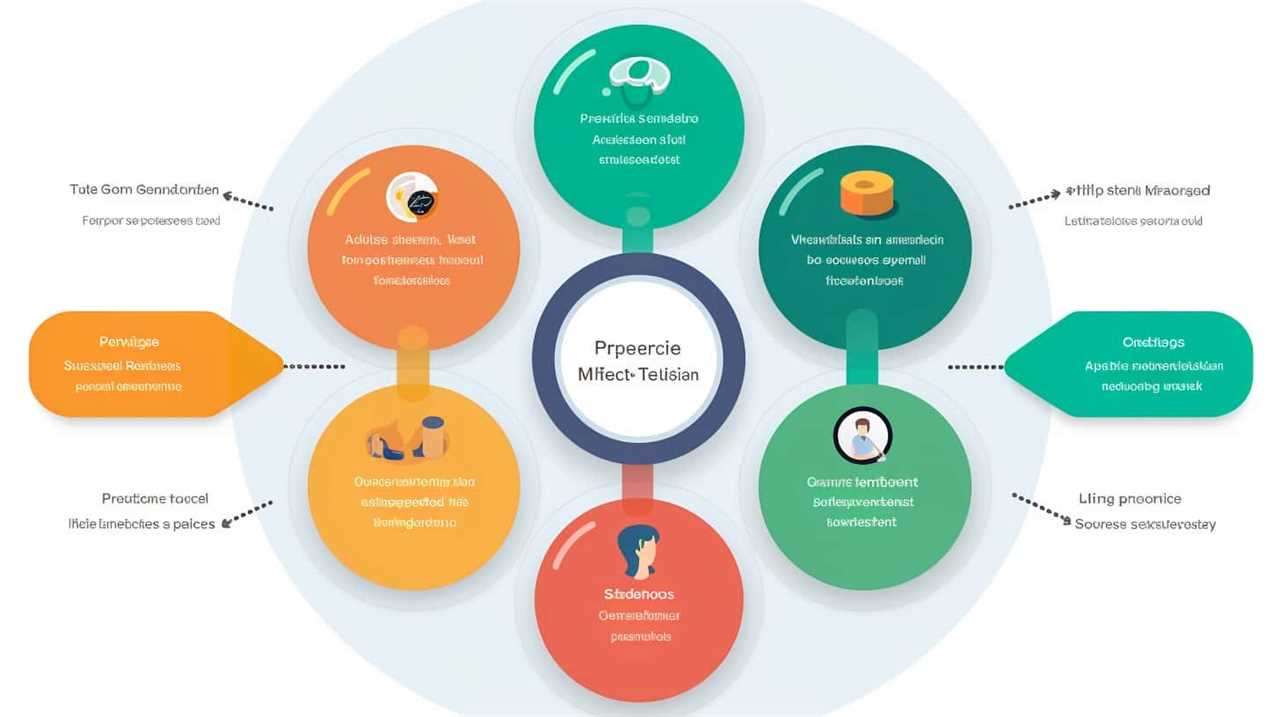Are you ready to transform your Google advertising strategy? Dynamic Search Ads (DSA) are what you should be looking into.
With the power of automation and dynamic ad generation, DSA has transformed the way businesses reach their target audience. By dynamically matching ads to search queries, DSA improves performance and increases the chances of reaching new customers.
In this article, we’ll explore the benefits of DSA and provide valuable insights on how to set up and optimize DSA campaigns.
Get ready to take your Google Advertising to new heights.

Key Takeaways
- Dynamic Search Ads (DSA) automatically generate ads based on the content of a website, saving time and effort for advertisers.
- DSA helps advertisers reach a broader audience by targeting relevant search queries and expanding keyword coverage.
- DSA improves ad performance by dynamically matching ads to search queries, leading to increased website traffic and conversions.
- DSA can be cost-effective as advertisers only pay for clicks on their ads, and it provides valuable insights into search terms and website performance.
What Are Dynamic Search Ads
Dynamic Search Ads (DSA) are ads that are automatically generated by Google Ads based on the content of a website. Implementing dynamic search ads offers several advantages for advertisers.
First, it allows them to capture more relevant traffic by dynamically matching ads to search queries. This expands keyword coverage and helps reach new customers.
Second, DSA improves ad performance by targeting the most relevant audience. Advertisers only pay for clicks on their ads, making it a cost-effective advertising strategy.
Additionally, DSA provides valuable insights into search terms and website performance, allowing advertisers to optimize their campaigns for better results.

To maximize the effectiveness of dynamic search ads, it’s important to regularly review and refine website content for accurate ad targeting. Using negative keywords, setting bid adjustments, and analyzing the search terms report are strategies that can further enhance DSA performance.
Benefits of Dynamic Search Ads
One of the key benefits of implementing Dynamic Search Ads is that they allow us to capture a larger amount of relevant traffic.
Here are three reasons why Dynamic Search Ads are essential for improving ad performance and achieving cost-effective advertising:
- Expanded keyword coverage: Dynamic Search Ads help in expanding keyword coverage by automatically generating ads based on the content of our website. This means that our ads have the potential to appear for a wider range of search queries, reaching new customers and increasing our visibility.
- Dynamically matched ads: With Dynamic Search Ads, our ads are dynamically matched to relevant search queries. This ensures that our ads are highly targeted and relevant to the user’s search intent, leading to improved ad performance and higher click-through rates.
- Cost-effective advertising: With Dynamic Search Ads, we only pay for clicks on our ads. This makes it a cost-effective advertising strategy as we aren’t charged for impressions or ad placements. By only paying for actual clicks, we can maximize our advertising budget and ensure that we’re getting the most value for our investment.
How to Set up Dynamic Search Ads
To set up Dynamic Search Ads, we need to begin by creating a DSA campaign in Google Ads.

This can be done by selecting the ‘New campaign’ option and choosing ‘Search’ as the campaign type. Then, select ‘Dynamic Search Ads’ as the subtype.
Next, specify the targeting options for your DSA campaign. You can choose to target your entire website or select specific web pages. It’s important to customize your ad headlines and descriptions to align with your branding.
Additionally, set a budget and bid strategy for your DSA campaign.
Once your campaign is live, regularly monitor and optimize it for better results.

Use Google Ads’ reporting tools to measure the success of your DSA campaign and make data-driven decisions for future optimizations.
Targeting Options for Dynamic Search Ads
Our approach to targeting options for Dynamic Search Ads is to maximize relevance and reach. Here are three key targeting options that can help advertisers achieve success with their DSA campaigns:
- Website Targeting: Advertisers can choose to target their entire website or specific web pages. This allows them to focus on promoting specific products, categories, or sections of their website, ensuring that their ads are highly relevant to the user’s search query.
- Auto Targets: With auto targets, advertisers can let Google Ads automatically generate targets based on their website content. This helps in expanding keyword coverage and reaching a broader audience.
- Page Feeds: Page feeds allow advertisers to manually specify the URLs they want to target. This can be useful for campaigns that require precise targeting, such as promoting specific landing pages or seasonal offers.
Customizing Ad Headlines and Descriptions
We can customize ad headlines and descriptions to align with our branding and attract more attention from potential customers. Customizing ad headlines allows us to create catchy and compelling messages that resonate with our target audience. By incorporating our unique selling points and brand voice into the headlines, we can differentiate ourselves from competitors and build brand recognition.
Additionally, customizing ad descriptions enables us to provide more detailed information about our products or services, enticing users to click on our ads. This level of customization not only improves ad performance but also increases the likelihood of conversions.

Through strategic and thoughtful customization of ad headlines and descriptions, we can optimize our campaigns and achieve better results.
Setting a Budget and Bid Strategy
Now let’s delve into the important aspect of determining our budget and bid strategy for dynamic search ads. Setting a budget and bid strategy is crucial for maximizing the effectiveness of our campaign and achieving optimal results. Here are three key factors to consider:
- Budget Optimization: Allocate your budget wisely by analyzing your campaign’s performance and adjusting accordingly. Focus on areas that generate the most conversions and allocate more budget to those segments. This will help optimize your spending and drive better results.
- Bid Management: Implement a strategic bid management strategy to ensure you’re bidding competitively and efficiently. Regularly monitor your bids, adjust them based on performance, and take advantage of bid adjustments for different website categories. This will help you stay ahead of the competition and maximize your return on investment.
- Continuous Optimization: Regularly monitor and optimize your campaign to improve performance. Analyze the search terms report to identify new keywords and negative keywords. Refine your targeting options, adjust your bids, and make necessary changes to your campaign settings. This continuous optimization will help you achieve better results over time.
Monitoring and Optimizing Dynamic Search Ads
Effective monitoring and optimization are essential for maximizing the performance of Dynamic Search Ads. Continuous improvement is crucial in ensuring that DSA campaigns are delivering the desired results.
By regularly measuring performance metrics such as click-through rates, conversion rates, and cost per conversion, advertisers can identify areas for improvement and make data-driven decisions.

Monitoring the search terms report allows advertisers to identify new keywords to target and negative keywords to exclude. It’s also important to review and refine website content to ensure accurate ad targeting.
By regularly optimizing DSA campaigns, advertisers can improve ad relevance, drive more qualified traffic, and increase conversions.
Successful monitoring and optimization strategies can help advertisers fully leverage the potential of Dynamic Search Ads and achieve their advertising goals.
Reviewing and Refining Website Content
To ensure optimal performance, we regularly review and refine the website content for accurate ad targeting in Dynamic Search Ads. This step is crucial in optimizing ad targeting and improving overall campaign effectiveness.

Here are three key reasons why reviewing website performance and refining content is essential:
- Increase Relevance: By reviewing website performance, we can identify areas where the content may not align with the targeted keywords. By refining the content, we can ensure that the ads generated by Dynamic Search Ads are highly relevant to the search queries.
- Improve Quality Score: A high-quality score is essential for achieving better ad rankings and lower costs. By regularly reviewing and refining website content, we can enhance the relevancy of our ads, leading to higher quality scores and improved ad performance.
- Enhance User Experience: A well-optimized website with relevant content not only attracts more visitors but also provides a better user experience. By reviewing and refining the website content, we can ensure that visitors find the information they need, leading to higher engagement and increased conversions.
Using Negative Keywords in Dynamic Search Ads
One important strategy in optimizing Dynamic Search Ads is utilizing negative keywords effectively to exclude irrelevant search queries. By adding negative keywords, advertisers can prevent their ads from appearing in search results that aren’t relevant to their products or services. This helps to improve the overall performance of the DSA campaign and ensures that the budget is spent on valuable clicks.
By reducing the number of irrelevant clicks, advertisers can increase the click-through rate and conversion rate, ultimately impacting the return on investment (ROI). Negative keywords allow advertisers to have more control over their ad targeting and ensure that their ads are shown to the most relevant audience.
Bid Adjustments for Different Website Categories
We can optimize the performance of Dynamic Search Ads by implementing bid adjustments for various website categories. By strategically adjusting our bids based on the performance of different website categories, we can effectively allocate our budget and maximize our return on investment.

Here are three bid adjustment strategies to consider:
- Analyze performance data: Measure the performance of your DSA campaign by analyzing key metrics such as click-through rate, conversion rate, and cost per conversion. Identify which website categories are driving the most valuable traffic and adjust your bids accordingly.
- Prioritize high-performing categories: Increase your bids for website categories that consistently deliver strong results. This will help you capture more traffic and increase your chances of generating conversions.
- Adjust bids for low-performing categories: If certain website categories are underperforming, consider decreasing your bids or excluding them altogether. This will allow you to allocate your budget more effectively and focus on categories that yield better results.
Analyzing the Search Terms Report
After implementing bid adjustments for different website categories, we can now delve into analyzing the search terms report to further optimize our Dynamic Search Ads campaign. Analyzing performance metrics is crucial for understanding the effectiveness of our ads and identifying areas for improvement. By reviewing the search terms report, we can gain valuable insights into the actual search queries that triggered our ads. This allows us to identify new keyword opportunities and optimize our targeting strategy. We can also use this report to identify irrelevant search terms and add them as negative keywords to improve the relevance of our ads. The table below illustrates the information provided in the search terms report:
| Search Term | Clicks | Impressions | CTR | Conversions |
|---|---|---|---|---|
| Keyword 1 | 10 | 100 | 10% | 2 |
| Keyword 2 | 5 | 50 | 10% | 1 |
| Keyword 3 | 8 | 80 | 10% | 0 |
| Keyword 4 | 15 | 150 | 10% | 3 |
| Keyword 5 | 12 | 120 | 10% | 1 |
Continuous Monitoring and Optimization
To ensure optimal performance, our team continuously monitors and optimizes our Dynamic Search Ads campaign. This allows us to make continuous improvements and track the performance of our ads.
Here are three reasons why continuous monitoring and optimization are crucial for the success of our campaign:

- Performance Tracking: By continuously monitoring our campaign, we can track the performance of our ads in real-time. This enables us to identify any issues or areas for improvement and make necessary adjustments to maximize our results.
- Continuous Improvement: Through ongoing optimization, we can fine-tune our targeting, keywords, and ad copy to ensure that our ads are reaching the right audience and generating the desired outcomes. This iterative approach allows us to continually improve the effectiveness of our campaign.
- Maximizing ROI: By regularly monitoring and optimizing our Dynamic Search Ads, we can ensure that we’re getting the most out of our advertising budget. This helps us maximize our return on investment and achieve our desired business goals.
Case Studies and Success Stories
Continuously monitoring and optimizing our Dynamic Search Ads campaign has resulted in impressive case studies and success stories. We have seen the impact of Dynamic Search Ads on website traffic and the measurable ROI it brings. Allow me to share some of these inspiring examples:
| Case Study | Impact |
|---|---|
| Clothing Retailer | 30% increase in conversions, 40% decrease in cost per conversion |
| E-commerce Website | 20% boost in revenue |
| Travel Agency | 50% increase in bookings |
These case studies demonstrate the effectiveness of Dynamic Search Ads across various industries, including retail, e-commerce, and travel. By leveraging the power of DSA, businesses have achieved significant improvements in conversions, cost per conversion, revenue, and bookings. The success stories speak for themselves, proving that Dynamic Search Ads revolutionize Google advertising. So, if you want to drive more relevant traffic to your website and see impressive results, it’s time to embrace the power of Dynamic Search Ads.
Increased Conversions and Decreased Costs
In our case studies, we’ve observed a significant increase in conversions and a noticeable decrease in costs with Dynamic Search Ads (DSA). Here are three reasons why DSA can help you achieve increased ROI and measure success:
- Targeted Traffic: DSA allows advertisers to capture more relevant traffic by dynamically matching ads to search queries. This means that your ads are shown to users who are actively searching for products or services related to your website.
- Cost-Effective Advertising: With DSA, advertisers only pay for clicks on their ads. This means that you aren’t wasting money on irrelevant clicks, leading to a decrease in costs and a higher return on investment.
- Insights and Optimization: DSA provides valuable insights into search terms and website performance. By regularly monitoring and optimizing your DSA campaigns, you can identify new keywords, exclude irrelevant queries, and make data-driven decisions to improve your ad performance.
With increased conversions and decreased costs, DSA is a powerful tool for revolutionizing your Google advertising strategy. Measure your success and achieve a higher ROI with Dynamic Search Ads.

Success Across Various Industries
We have seen how Dynamic Search Ads (DSA) can lead to increased conversions and decreased costs. Now, let’s explore how DSA has achieved success across various industries. DSA’s success can be measured through increased website traffic, higher conversions, and improved return on investment (ROI). Each industry requires specific strategies to maximize the benefits of DSA. For example, in the retail industry, DSA helps showcase a wide range of products and drives targeted traffic to specific product pages. In the travel industry, DSA can promote vacation packages or hotel bookings based on user search queries. And in the services industry, DSA can generate leads by dynamically creating ads for different service offerings. Here’s a table illustrating the success of DSA across different industries:
| Industry | Success Measurement | Industry Specific Strategies |
|---|---|---|
| Retail | Increased product views | Showcase product inventory |
| Travel | Higher bookings | Promote vacation packages |
| Services | Increased leads | Highlight service offerings |
DSA’s versatility and industry-specific strategies make it a powerful tool for businesses to achieve success in their respective industries.
Frequently Asked Questions
How Do Dynamic Search Ads Revolutionize Google Advertising?
Dynamic Search Ads revolutionize Google advertising by significantly improving click-through rates and providing numerous benefits for small businesses. They capture relevant traffic, expand keyword coverage, and offer cost-effective advertising solutions.
What Are Some Specific Targeting Options Available for Dynamic Search Ads?
For advanced targeting options in Dynamic Search Ads, we can specify the website or specific web pages. This allows us to maximize ad performance by aligning ads with our branding and reaching the right audience.

How Can Advertisers Customize Their Ad Headlines and Descriptions in Dynamic Search Ads?
To customize ad headlines and descriptions in dynamic search ads, advertisers have various options. Personalized ads have numerous benefits, such as higher click-through rates and improved ad relevance, which can lead to better campaign performance and increased conversions.
What Are Some Best Practices for Monitoring and Optimizing Dynamic Search Ads?
Monitoring strategies and optimization techniques are crucial for maximizing the performance of dynamic search ads. One example is regularly analyzing the search terms report to identify new keywords and negative keywords for better ad targeting.
Can You Provide Examples of Success Stories and Case Studies of Businesses Using Dynamic Search Ads in Various Industries?
Success stories and case studies showcase the effectiveness of dynamic search ads in various industries. Advertisers have reported increased website traffic, conversions, and revenue. DSA has revolutionized Google advertising for businesses across retail, travel, and services.
Conclusion
In conclusion, Dynamic Search Ads revolutionize Google Advertising by automating ad generation and improving ad performance.

With the ability to dynamically match ads to search queries, businesses can save time, reach their target audience, and expand their keyword coverage.
By leveraging the power of Dynamic Search Ads, businesses can take their Google Advertising strategy to new heights, just like a rocket propelling to the stars.
So why wait? Start using Dynamic Search Ads today and witness remarkable results for your business.








